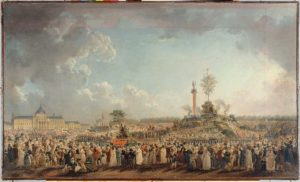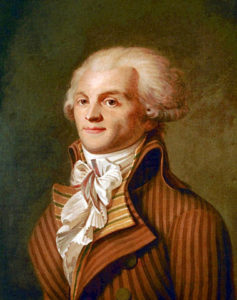Storming of the Cults: A Revolutionary Remembrance
 La fête de l'Être Suprême, au Champ-de-Mars (Festival of the Supreme Being) by Pierre-Antoine Demachy, c. 1794
La fête de l'Être Suprême, au Champ-de-Mars (Festival of the Supreme Being) by Pierre-Antoine Demachy, c. 1794 In the modern American consciousness, the French Revolution might evoke imagery of guillotines, Marie Antoinette, powdered wigs, and lots of angry French citizens. For humanists, the French Revolution marks the beginning of a new age of enlightenment, freedom, and rational thought.
On this Bastille Day, it’s worth exploring one of the strangest aspects of the French Revolution, the coup d’etat that ushered in the Age of Revolution: religion.
For historians, the French Revolution is full of contradictions. Born out of a century-long tradition of enlightenment thought, the early years of the revolution promised a more secular, free, and democratic state for men only. This technically included Black men as well, but no one of the female gender (although many women, like Olympe de Gouges, worked hard to get the right to vote). In the early years, the newly created National Assembly wrote the Civil Constitution of the Clergy—essentially an oath for priests and bishops to prove their loyalty to the French state over the Vatican. Some took the oath, others didn’t.
Two classes of clergy emerged: those known as juring priests, who took the oath, and refractory priests who didn’t. In many rural areas of France, parish churches were the major source of authority—a fact that threatened the new republican bureaucracy. The power of the church in the countryside and the influence of refractory priests was a major problem for the revolution in its early days. In 1792, Catholicism was officially banned.
By 1793 the revolution turned more, well, revolutionary. In January of that year, King Louis XVI was executed. Revolutionaries implemented the metric system and a brand-new calendar, with names free from religious or royal influence: the French Republican Calendar. Unsurprisingly, these sweeping changes evoked strong negative reactions from millions of confused and angry French citizens.
After reorganizing and then banning the Catholic Church, revolutionaries set up the Cult of Reason, a new atheistic religion devoted to the ideals of rational thought. By November , Notre-Dame cathedral had been converted into “The Temple to the Goddess Reason.” (Interestingly, later in the revolution, Notre-Dame was converted into a wine warehouse.)
The Cult of Reason was supposed to replace Christianity as the new state belief system—hardly true to its professed ideal of secularism. Churches around the country were converted to temples of reason and new rituals, like the wild Roman-inspired Festival of Reason, took the place of Christian services.

Maximilien Robespierre
By 1794 the Cult of Reason was replaced by the Cult of the Supreme Being, a brainchild of the infamously guillotine-happy Maximilien Robespierre. Robespierre detested the scandalous and atheistic nature of the Cult of Reason and felt that belief in a god was necessary to achieve republican virtue in France (an idea he borrowed from Voltaire). The Cult of the Supreme Being took inspiration from deism, an Enlightenment-era belief system revolving around a supreme creator or god that does not interfere in the workings of the universe. The Cult of the Supreme Being became the official civic religion of France as its founder rose to greater prominence in the revolutionary government. Robespierre functioned as a kind of mixed political and religious leader, headlining the 1794 Festival of the Supreme Being like a revolutionary Beyoncé at Coachella.
Robespierre’s fall was as swift as his rise; he was executed in 1794, the same year his religion was established. His death marked the end of the Reign of Terror, in which he was instrumental, and the Cult of the Supreme Being. The cult was officially banned by Napoleon in 1802, when he decided to make nice with the Vatican in exchange for legitimacy as France’s new emperor.
However, despite the regime change, some aspects of France’s brush with radical secularism remained. Education, which Napoleon championed, remained under the purview of the state and not the church. This departure from tradition marked a new modern view of the state, which was no longer a subordinate to the church.
The Enlightenment ideals that influenced French revolutionaries are the same ideals that inspired American revolutionaries around the same time. It’s well-known that many of our Founding Fathers were either Christian deists or non-Christian deists, whose ideas about separation of church and state descend directly from those of John Locke and Voltaire, some of the original humanists.
The French Revolution was the shocking event that spawned a million works of art and ushered the West into the modern era. It provides a valuable cautionary tale against religious extremes and some of the most fascinating and bizarre episodes of history. Happy Bastille Day! May the Goddess Reason be with you.
